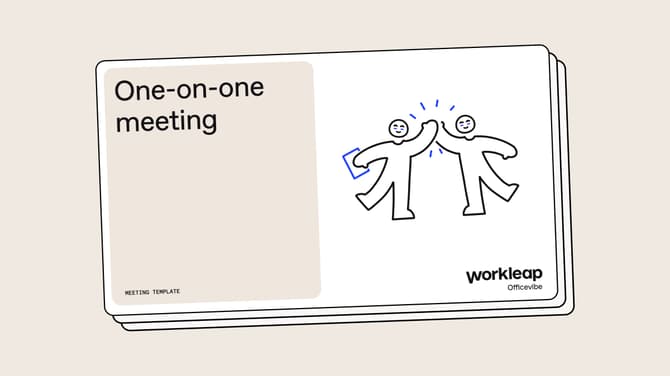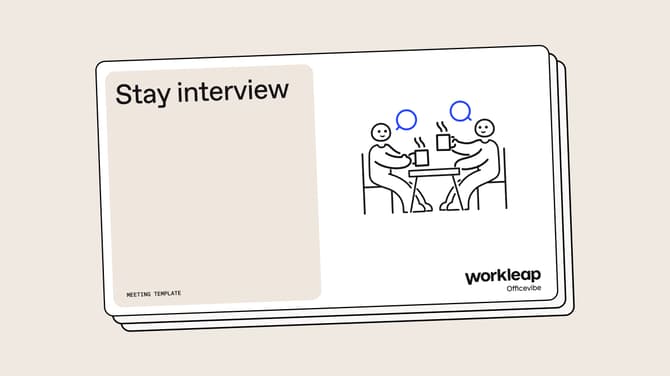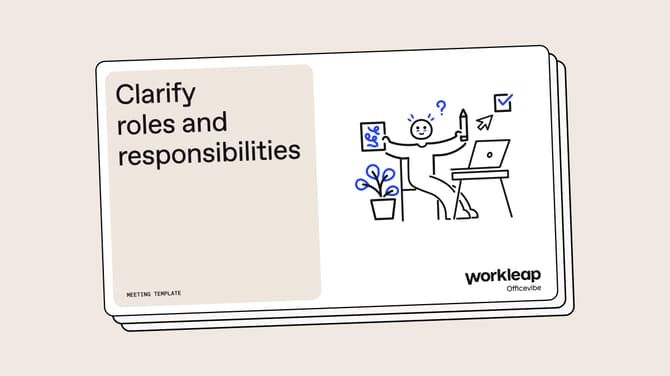Employee engagement: the industry term du jour – and with good reason. Employee engagement refers to the emotional or mental connection someone might have to their job and company. Essentially, it's how invested an employee is in what they do and where they're doing it.
We know that employees are the lifeblood of every organization. So it stands to reason that if your people are happy with what they do and are eager to wake up every day to tick tasks off their to-do lists, then your organization will be better primed for success.
While traditional ways of engaging employees may have worked in the past, most modern professionals need more than free coffee or casual Fridays to keep them feeling productive and inspired. Let's explore why.
Exclusive online summit
·
May 23 2024
Moments that matter: how to seed great work
What's in this article
The importance of employee engagement initiatives
The most successful teams are made up of engaged employees who want to contribute to their company's mission and collective goals.
But actively engaging your employees can prove easier said than done, especially during challenging moments like an organizational restructuring or a shift to a hybrid work model. In these bumpier contexts, the importance of employee engagement can't be overstated as a more engaged workforce can result in:
- Higher productivity
- More collaborative teamwork
- Stronger company culture
- Genuine job satisfaction
- Lower risk of burnout
- Better employee retention
- Reduced employee turnover rates
And the list goes on.
When an employee is passionate about their career and feels connected to their company values, it shows in their day-to-day work. But with the shift to remote work, it's become more challenging for managers to keep the pulse on how their team members are feeling. You can help keep your employees engaged by making time for interesting, motivational, and downright fun activities and initiatives.
14 effective employee engagement ideas for your team
Let's dive into some employee engagement ideas that are more apropos for the 21st-century workplace.
1. Create a safe space for employee feedback...
One of the best ways you can engage employees is by listening to what they have to say on anything from interpersonal challenges and administrative policies to creative direction and company vision. Creating a continuous feedback loop to collect your team's opinions, questions, and comments will help clue you in on how your employees feel.
To ensure all your employees feel comfortable expressing their thoughts and new ideas, you should offer them the possibility of submitting feedback anonymously. This will allow your team to comment on what matters to them more freely and without fear of repercussion.
💡Discover some of the best methods and tools for collecting anonymous employee feedback.
2. ...and always act on it
Collecting feedback is an ongoing process but it's just half the battle; what matters most is how you respond to it. By acting on their comments, you're encouraging employees to keep submitting their honest thoughts which can help bring about positive change for their own personal development, your team, and even the entire company.
Read how you can respond to feedback so your employees feel valued.
3. Send out pulse surveys
One of the most tried-and-true employee engagement activities in the management book is to send out pulse surveys. Pulse surveys are a quick and efficient way to measure if you're sufficiently engaging employees by asking them a series of short but poignant questions (with qualitative or quantitative answers on a sliding scale) like:
- Do you have the resources necessary to grow in your role?
- Are you satisfied with the amount of feedback you get from your manager?
- Do you feel like your employer cares about employee health?
- What can your organization do to boost employee satisfaction?
Pulse survey tools in software like Officevibe can help you keep track of how your people feel in a safe space, allowing employees to share their thoughts more candidly.
💡Need some inspiration to craft your first survey? Try out these 25 pulse survey questions designed to see if your employees feel engaged.
4. Make sure your team's objectives are aligned
According to Officevibe data, 73% of employees feel their managers can define more precise goals.
When you're not all on the same page, it's easy for employee engagement to slip; misaligned objectives can lead to frustration and frustration can lead to resentment, ultimately hurting employee happiness. Clarity around what you expect from your people (and what they expect from you) is a non-negotiable if you want your team to succeed.
Using goal-setting tools like the OKR (Objectives and Key Results) framework can help your team reassess and realign collective and individual goals and improve team performance.
Goal setting is an art form. Master it with Officevibe's essential OKR email course.
5. Don't let recognition slip through the cracks
No matter how busy things get, it's crucial to keep employee recognition at the forefront. Since our data shows that 34% of employees report unhappiness with how frequently they're recognized at work, neglecting this vital element of employee engagement can lead to high (and costly) turnover rates for your company. Recognize employees for their wins, big and small, express your gratitude for the time they put in, and show your employees how much you value their contributions.
💡Get inspired by these 27 employee recognition message examples and send your team a few kind words to boost employee performance and engagement.
6. Encourage professional development
Learning is a lifelong affair and as a manager or HR professional, it's part of your raison d'être to help your people grow. Cultivate employee engagement on your teams by providing opportunities for career development with workshops, short courses, lunch and learns, or mentorship programs. You can even invite a colleague from another unit to discuss a lesser-known topic to promote cross-team communication and learning.
Help your employees sharpen their skill sets for their current roles, or encourage them to get out of their comfort zones and tackle a new competency that will help them land a new title on your team or in a different department.
7. Connect with your team on a personal level
You might spend 40 hours a week chatting and working alongside your team members, but how well do you really know them? While professional boundaries are healthy and necessary, it's also important to learn what they're passionate about beyond their work and engage them on a personal level. You might learn that some of your coworkers are avid readers, hiking enthusiasts, or trivia buffs, so why not organize a book club, a trek through the woods, or a game evening as a team-building activity?
Connecting with your employees can be challenging, especially if you have remote team members. If you have the opportunity to meet offsite for a few hours, it can go a long way in fostering more genuine employee engagement.
👉 Amplify team connections, build trust, and encourage employee engagement with these 10 team-building activities.
8. Create a memorable onboarding experience for new employees
The hiring process can be stressful, but onboarding doesn't have to be. Engagement begins even before a new employee logs on for their first day, so it's crucial to make sure new hires are fully equipped with the resources they need to succeed in their job.
Make sure the latest addition to your team is comfortable and has a clear understanding of the scope of their position and their role within the organization. Luckily tools like Workleap Onboarding exist to help you offer your remote employees the same authentic onboarding process as you would any onsite employee.
9. Prioritize employee well-being
We know that mental health and wellness have taken a hit in the last few years, but did you know that, according to Officevibe data, 47% of employees are feeling overwhelmed at work? That's a jarring statistic. This means that many employees are signaling to their managers that they are feeling stressed, burnt out, and unhappy.
If you want to boost employee engagement, you need to make sure your team members feel safe enough to speak up when they can no longer maintain a healthy work-life balance. Sending employee wellness surveys can help you pinpoint areas of the employee experience you might need to reassess to keep your employees happy. You can also promote a mindful lifestyle by holding in-person or virtual yoga sessions, providing healthy snacks at the office, or offering access to wellness applications.
10. Foster a positive company culture
When you make employee well-being a priority, you begin to elevate your entire employee experience. Positive company culture is rooted in mutual respect and can lead to stronger collaboration, higher employee productivity, and overall happier, more engaged employees.
When your team feels supported and motivated by their peers and company leadership, they will be better equipped to reach their personal and professional goals as well as broader collective goals.
11. Promote equity, diversity, and inclusion
The workplace must be a safe space for every employee, regardless of gender, socio-economic background, race, or religion. To truly support your employees, you need to foster a company culture that is accessible and inclusive for every team member.
Get the conversation going with a series of diversity, equity, and inclusion survey questions that will encourage employees to speak freely on topics that matter the most to them. These types of engagement efforts aim to uplift employee voices and make sure everyone is involved in important company discussions that can shape workplace culture.
12. Hold one-on-one meetings with your employees
Sometimes a simple conversation can be the best way to connect with your employees. Regular one-on-one meetings can clear up confusion for ongoing tasks, ensure alignment on team objectives, and can help resolve internal conflicts.
Asking the right questions can help you improve employee engagement by getting a clearer picture of your team's reality. We've put together a list of some useful one-on-one meeting questions to prompt conversations with your employees:
- Are you excited about what you’re currently working on?
- Are there things happening on the team that make it difficult to collaborate?
- Do you feel challenged at work? Are you learning new things?
- Is there something we could do as a team to improve recognition?
Uncover more benefits of holding regular one-on-one meetings.
13. Include your team in decision-making
Many HR professionals and team leaders make the cardinal error of excluding their direct reports from important conversations that affect daily operations. More often than not, your employees will be the ones most impacted by high-level decisions usually dictated by senior leadership.
Managers should tap into their best resource (their employees) to get feedback before implementing new policies or starting new projects. Get your employees involved by opening the floor for feedback and questions. Giving your team a seat at the table to express their thoughts will do wonders for making employees feel valued.
14. Encourage employee activism and volunteering
Your team is dedicated and that extends well beyond the workplace. Learn what causes are dear to their hearts and organize an offsite volunteer day. A more altruistic employee engagement strategy like this one is a great opportunity for team building and can bond peers over common goals and shared values.
Every organization has a social responsibility to contribute to the greater good, and engaging in acts of community service is a wonderful way to inspire employees.
Implement an employee engagement program in your workplace
Improving employee engagement can seem like a gargantuan task if you don't know where to start. Should you dive right into organizing team bonding activities or should you hold one-on-one meetings to have a quick chat? The truth is, there is no wrong answer.
Remember: employee engagement will look different for each of your team members. The best way to move forward and foster a happy work environment is to get your people motived and excited to perform at their best.
Regardless of how you engage with your employees, the important thing is to make the time to check in with them regularly and connect with them in a way that suits your team's needs and ambitions.
Equip HR and managers with tools to engage, recognize, and drive performance.




